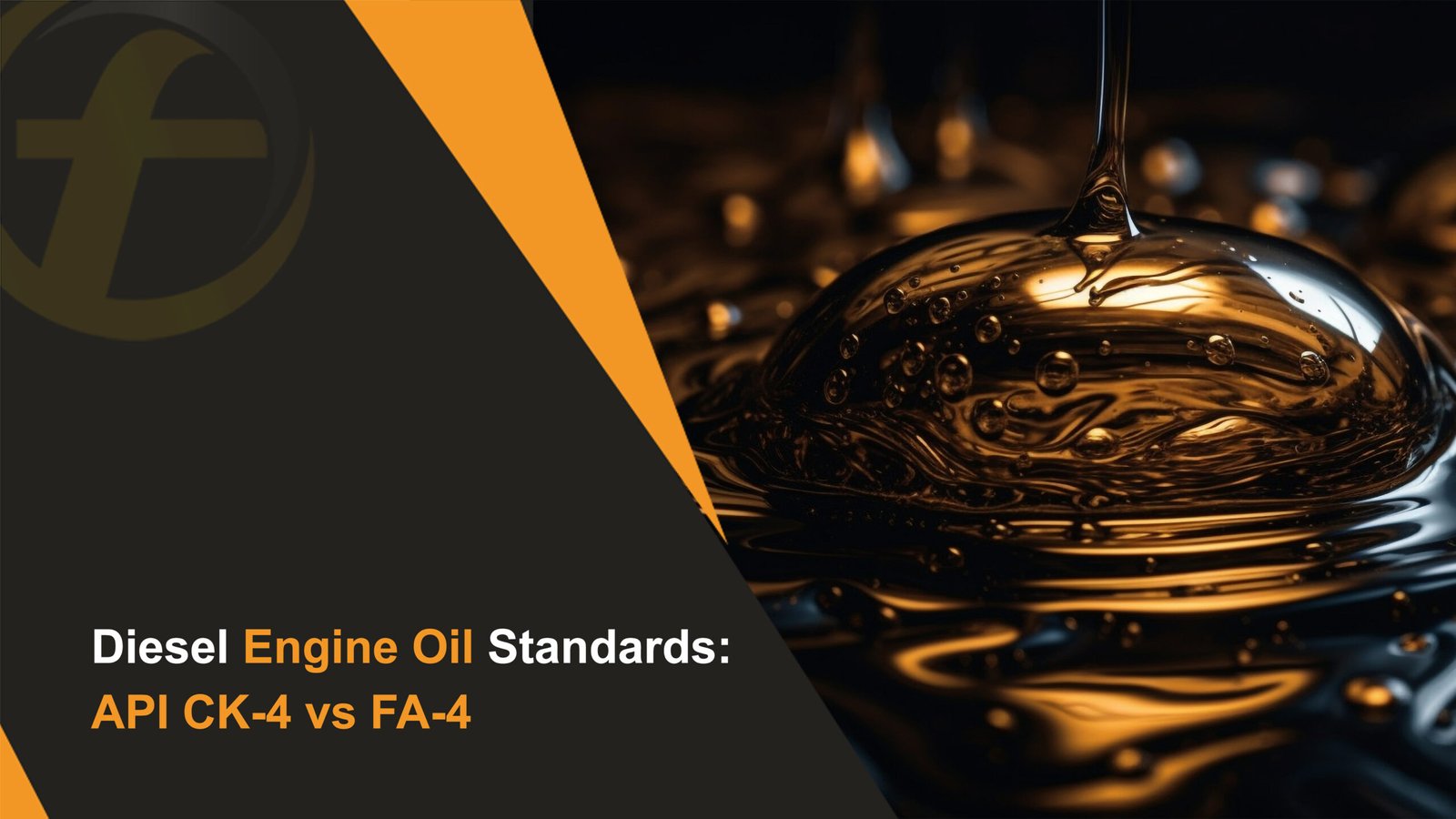
In heavy-duty diesel engines, picking the right engine oil is very important. The right oil helps engines run better, last longer, and follow the manufacturer’s rules. The new API CK-4 and API FA-4 oils can be confusing for technicians and fleet managers. This simple guide will explain the main differences, which engines each oil works with, and the benefits of using these advanced oils.
The Move to CK-4 and FA-4 Engine Oils
In December 2016, the American Petroleum Institute (API) introduced CK-4 and FA-4 engine oils. These oils replaced the old CJ-4 oils that were used since 2006.
The change happened because engines and rules were changing. New engines needed oils that could:
- Produce fewer emissions and be cleaner for the environment
- Help save fuel
- Last longer without breaking down
- Protect the engine from wear and damage
- Allow longer times between oil changes
For mechanics and technicians, knowing the difference between CK-4 and FA-4 oils is important. It helps them pick the right oil to keep engines running smoothly and safely.
API CK-4 Engine Oil: A Flexible Choice
API CK-4 engine oil is a newer type of oil that replaced the older CJ-4 oils. It works even better and keeps engines running strong.
Why CK-4 is Better:
- Lasts longer and resists breaking down (up to 2 times better than CJ-4)
- Controls foaming in the oil
- Stays strong under high pressure
- Protects engine parts from damage
- Reduces wear, especially in the valve area
Where You Can Use It:
- Older diesel engines made before 2017
- Equipment that used older oils like CJ-4, CI-4, or CH-4
- Mixed fleets with different engine types
- Off-road machines and heavy-duty equipment
- Situations that need thicker oils
Because CK-4 works with older oils, it’s a great choice for garages and maintenance teams that work on many types of machines.
API FA-4 Engine Oil: The Fuel-Saving Choice
API FA-4 engine oil is a newer type of oil made for modern engines. It focuses on saving fuel and helping engines run cleaner.
Why FA-4 is Special:
- Helps save more fuel
- Works well at high temperatures
- Reduces carbon dioxide emissions
- Lasts long without breaking down
- Protects engine parts just like CK-4
Where You Can Use It:
- Made mainly for diesel engines from 2017 and newer
- Not for older engines
- Only use if the engine maker recommends it
- Usually comes in thinner grades, like SAE 10W-30
Because FA-4 is not for older engines, technicians need to be careful and only use it in the right engines.
Key Differences Technicians Should Know
Technicians need to understand the main differences between CK-4 and FA-4 oils to keep engines running their best.
Viscosity (Oil Thickness)
- CK-4 oils: Come in regular thicknesses like 15W-40, 10W-30, 5W-40
- FA-4 oils: Mostly thinner oils with special low HTHS values
High-Temperature High-Shear (HTHS) Viscosity
- CK-4 oils: HTHS ≥ 3.5 cP (thicker at high temps)
- FA-4 oils: HTHS 2.9–3.2 cP (thinner at high temps, helps save fuel)
This thinner oil in FA-4 helps engines use less fuel but can only be used in engines made for it.
Additives in the Oil
- CK-4 oils: Made to protect a wide range of engines
- FA-4 oils: Made to save fuel while still protecting newer engines
Engine Oil Compatibility: What Technicians Should Know
Choosing the right oil is very important. Using the wrong oil can damage engines. Here’s a simple guide for CK-4 and FA-4 oils.
When to Use CK-4 Oils:
- In any engine that used older oils like CJ-4, CI-4 Plus, CI-4, or CH-4
- For mixed fleets with different engine types
- When the engine maker does not specifically say FA-4 is needed
- In older engines and off-road equipment
- When you are unsure which oil to use
When to Use FA-4 Oils:
- Only in engines made for FA-4 oils
- When the engine maker specifically recommends FA-4
- Mostly in diesel engines from 2017 and newer
- When saving fuel is very important and the engine is compatible
- In fleets that can keep separate oils for different
Important: Always check the engine maker’s guide before using FA-4. Using it in the wrong engine can cause fast wear or serious engine damage.
Performance Benefits: Comparing CK-4 and FA-4 Oils
Both CK-4 and FA-4 oils are better than older oils, but each has its own strengths.
CK-4 Oil Advantages:
- Lasts longer: Resists breaking down (2x better than CJ-4)
- Fuel economy: Standard
- Protects engine parts: Excellent
- Works with older engines: Yes, fully compatible
- Emissions: Cleaner than CJ-4
- Use: Works on many types of engines, on-road and off-road
- Risk: Low – safe choice for most engines
FA-4 Oil Advantages:
- Lasts longer: Similar to CK-4
- Fuel economy: Better (saves 0.5–2%)
- Protects engine parts: Excellent, but only in engines made for it
- Works with older engines: No, only for 2017+ engines
- Emissions: Best for reducing CO₂
- Use: Only for newer on-road engines
- Risk: Higher if used in the wrong engine
Real-World Performance: What Tests Show
Tests and real-world use show how CK-4 and FA-4 oils perform in engines.
CK-4 Performance:
- Lasts longer without breaking down – up to 25% better than old CJ-4 oils
- Reduces engine wear – about 20% less metal in used oil
- Controls foaming in oil – up to 60% better
- Allows longer oil change intervals – 10–20% more in many engines
FA-4 Performance:
- Helps save fuel – about 1.2% better than CK-4 oils
- Protects engine parts well in engines made for it
- Saves $500–$800 per year per truck on fuel
- Reduces CO₂ emissions – 2–3 tons per truck per year
How Maintenance Facilities Can Use CK-4 and FA-4 Oils
Switching to new oils like CK-4 and FA-4 needs some careful planning. Here’s a simple guide for technicians:
For Mixed Fleets (Old and New Engines):
- Keep both oils: Store CK-4 and FA-4 separately with clear labels
- Use colors: Color-code oil types to avoid mistakes
- Update records: Make sure maintenance logs show which oil to use
- Train staff: Make sure everyone knows which engines can use FA-4
For Newer Fleets (Mostly 2017+ Engines):
- Switch gradually: Start using FA-4 as new engines arrive
- Monitor performance: Check oil regularly to see how it’s working
- Work with suppliers: Pick the best oil thickness (viscosity) for each engine
For Service Facilities:
- Teach customers: Explain the difference between CK-4 and FA-4
- Keep clear records: Write down exactly which oil was used
- Stock both oils: Be ready to service different types of engines
Final Thoughts
Knowing the difference between API CK-4 and API FA-4 engine oils is very important for keeping diesel engines running well. Both oils are better than older oils, but each works best in certain engines.
Technicians should follow engine maker instructions, consider the types of engines in their fleet, and think about how the engines are used. FA-4 oils save fuel but should only be used in engines made for them because they are thinner.
Choosing the right oil depends on your equipment. When used correctly, both CK-4 and FA-4 oils give excellent engine protection and performance for modern diesel engines.
FAQs
Q1: Can I mix CK-4 and FA-4 oils in an emergency?
It’s not ideal, but mixing them won’t cause immediate damage. The oil won’t work as well as it should, so switch back to the recommended oil as soon as possible.
Q2: Will using FA-4 in an older engine cause damage?
Yes, it can. FA-4 is thinner and may not protect older engines properly, which can cause faster wear.
Q3: Do these oils need special filters?
No. Standard filters that worked with older oils will work fine with CK-4 and FA-4.
Q4: How can I tell which oil is which?
Check the API donut symbol on the container. CK-4 oils say “API CK-4” and FA-4 oils say “API FA-4.” FA-4 oils also have a special shaded part on the donut to make them easier to spot.

Editor-at-Large
A passionate writer in the lubricant industry, Awais Iqbal has been covering oils, greases, and industrial fluids since the start of his career. At 25, he’s already written for blogs, catalogs, and brand guides across the UAE. Awais’s insights help companies connect with their audience, and his clear, helpful writing style is trusted by brands in the region.


